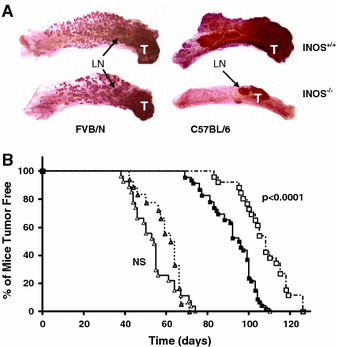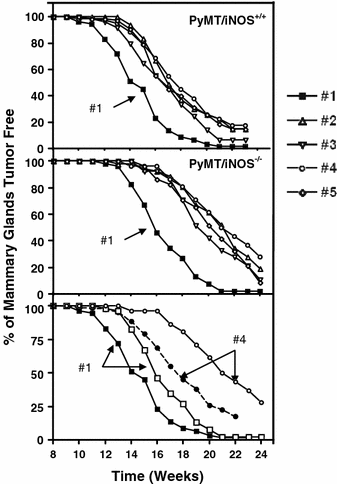Effects of FVB/NJ and C57Bl/6J strain backgrounds on mammary tumor phenotype in inducible nitric oxide synthase deficient mice
- PMID: 17206489
- PMCID: PMC1829418
- DOI: 10.1007/s11248-006-9056-9
Effects of FVB/NJ and C57Bl/6J strain backgrounds on mammary tumor phenotype in inducible nitric oxide synthase deficient mice
Abstract
The ability to genetically manipulate mice has led to rapid progress in our understanding of the roles of different gene products in human disease. Transgenic mice have often been created in the FVB/NJ (FVB) strain due to its high fecundity, while gene-targeted mice have been developed in the 129/SvJ-C57Bl/6J strains due to the capacity of 129/SvJ embryonic stem cells to facilitate germline transmission. Gene-targeted mice are commonly backcrossed into the C57Bl/6J (B6) background for comparison with existing data. Genetic modifiers have been shown to modulate mammary tumor latency in mouse models of breast cancer and it is commonly known that the FVB strain is susceptible to mammary tumors while the B6 strain is more resistant. Since gene-targeted mice in the B6 background are frequently bred into the polyomavirus middle T (PyMT) mouse model of breast cancer in the FVB strain, we have sought to understand the impact of the different genetic backgrounds on the resulting phenotype. We bred mice deficient in the inducible nitric oxide synthase (iNOS) until they were congenic in the PyMT model in the FVB and B6 strains. Our results reveal that the large difference in mean tumor latencies in the two backgrounds of 53 and 92 days respectively affect the ability to discern smaller differences in latency due to the Nos2 genetic mutation. Furthermore, the longer latency in the B6 strain enables a more detailed analysis of tumor formation indicating that individual tumor development is not stoichastic, but is initiated in the #1 glands and proceeds in early and late phases. NO production affects tumors that develop early suggesting an association of iNOS-induced NO with a more aggressive tumor phenotype, consistent with human clinical data positively correlating iNOS expression with breast cancer progression. An examination of lung metastases, which are significantly reduced in PyMT/iNOS-/- mice compared with PyMT/iNOS+/+ mice only in the B6 background, is concordant with these findings. Our data suggest that PyMT in the B6 background provides a useful model for the study of inflammation-induced breast cancer.
Figures

 FVB mice N = 44,
FVB mice N = 44,  B6 mice N = 46. (B) Whole mounts of mammary glands from 3 week old PyMT/iNOS+/+ mice of the FVB (left panel) and B6 (right panel) strains
B6 mice N = 46. (B) Whole mounts of mammary glands from 3 week old PyMT/iNOS+/+ mice of the FVB (left panel) and B6 (right panel) strains
 PyMT/iNOS+/+ FVB N = 44,
PyMT/iNOS+/+ FVB N = 44,  PyMT/iNOS−/− FVB N = 57,
PyMT/iNOS−/− FVB N = 57,  PyMT/iNOS+/+ B6 N = 46,
PyMT/iNOS+/+ B6 N = 46,  PyMT/iNOS−/− B6 N = 26
PyMT/iNOS−/− B6 N = 26
 FVB N = 32,
FVB N = 32,  B6 N = 44. Data are means ± SEM. (B) Tumor latency for individual B6 PyMT/iNOS+/+ and PyMT/iNOS−/− tumors. Data were derived from examining 460 B6 PyMT/iNOS+/+
B6 N = 44. Data are means ± SEM. (B) Tumor latency for individual B6 PyMT/iNOS+/+ and PyMT/iNOS−/− tumors. Data were derived from examining 460 B6 PyMT/iNOS+/+ and 260 PyMT/iNOS−/−
and 260 PyMT/iNOS−/− tumors
tumors


References
-
- {'text': '', 'ref_index': 1, 'ids': [{'type': 'DOI', 'value': '10.1016/j.ydbio.2006.03.030', 'is_inner': False, 'url': 'https://doi.org/10.1016/j.ydbio.2006.03.030'}, {'type': 'PubMed', 'value': '16678815', 'is_inner': True, 'url': 'https://pubmed.ncbi.nlm.nih.gov/16678815/'}]}
- Boras-Granic K, Chang H, Grosschedl R, Hamel PA (2006) Lef1 is required for the transition of Wnt signaling from mesenchymal to epithelial cells in the mouse embryonic mammary gland. Dev Biol 295:219–231 - PubMed
-
- {'text': '', 'ref_index': 1, 'ids': [{'type': 'PubMed', 'value': '12868567', 'is_inner': True, 'url': 'https://pubmed.ncbi.nlm.nih.gov/12868567/'}]}
- Cardiff RD (2003) Mouse models of human breast cancer. Comp Med 53:250–253 - PubMed
-
- {'text': '', 'ref_index': 1, 'ids': [{'type': 'DOI', 'value': '10.1023/A:1018712905244', 'is_inner': False, 'url': 'https://doi.org/10.1023/a:1018712905244'}, {'type': 'PubMed', 'value': '10219910', 'is_inner': True, 'url': 'https://pubmed.ncbi.nlm.nih.gov/10219910/'}]}
- Cardiff RD, Wellings SR (1999) The comparative pathology of human and mouse mammary glands. J Mammary Gland Biol Neoplasia 4:105–122 - PubMed
-
- {'text': '', 'ref_index': 1, 'ids': [{'type': 'DOI', 'value': '10.1111/j.0021-8782.2004.00309.x', 'is_inner': False, 'url': 'https://doi.org/10.1111/j.0021-8782.2004.00309.x'}, {'type': 'PMC', 'value': 'PMC1571327', 'is_inner': False, 'url': 'https://pmc.ncbi.nlm.nih.gov/articles/PMC1571327/'}, {'type': 'PubMed', 'value': '15255957', 'is_inner': True, 'url': 'https://pubmed.ncbi.nlm.nih.gov/15255957/'}]}
- Eblaghie MC, Song SJ, Kim JY, Akita K, Tickle C, Jung HS (2004) Interactions between FGF and Wnt signals and Tbx3 gene expression in mammary gland initiation in mouse embryos. J Anat 205:1–13 - PMC - PubMed
-
- {'text': '', 'ref_index': 1, 'ids': [{'type': 'DOI', 'value': '10.1002/ijc.11178', 'is_inner': False, 'url': 'https://doi.org/10.1002/ijc.11178'}, {'type': 'PubMed', 'value': '12794750', 'is_inner': True, 'url': 'https://pubmed.ncbi.nlm.nih.gov/12794750/'}]}
- Ellies LG, Fishman M, Hardison J, Kleeman J, Maglione J, Manner CK, Cardiff RD, MacLeod CL (2003) Mammary tumor latency is increased in mice lacking the inducible nitric oxide synthase. Int J Cancer 106:1–7 - PubMed
Publication types
MeSH terms
Substances
Grants and funding
LinkOut - more resources
Full Text Sources
Other Literature Sources
Molecular Biology Databases
Research Materials

